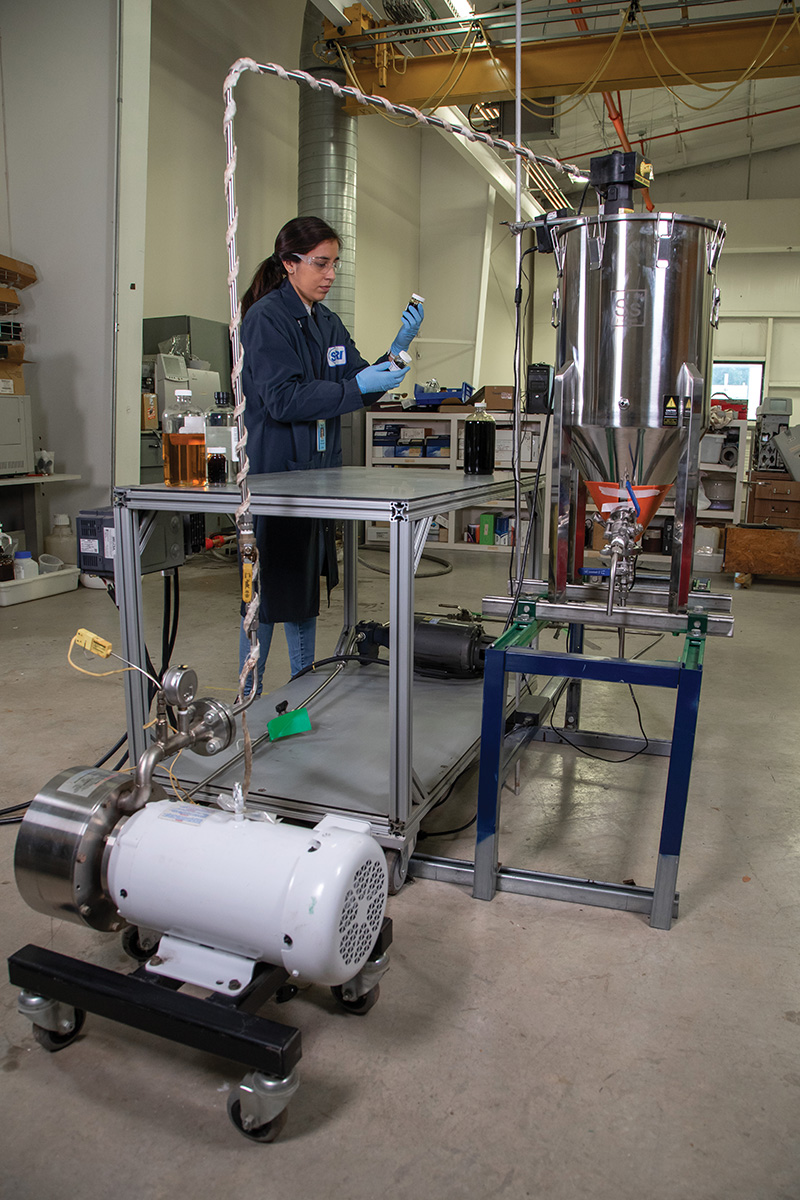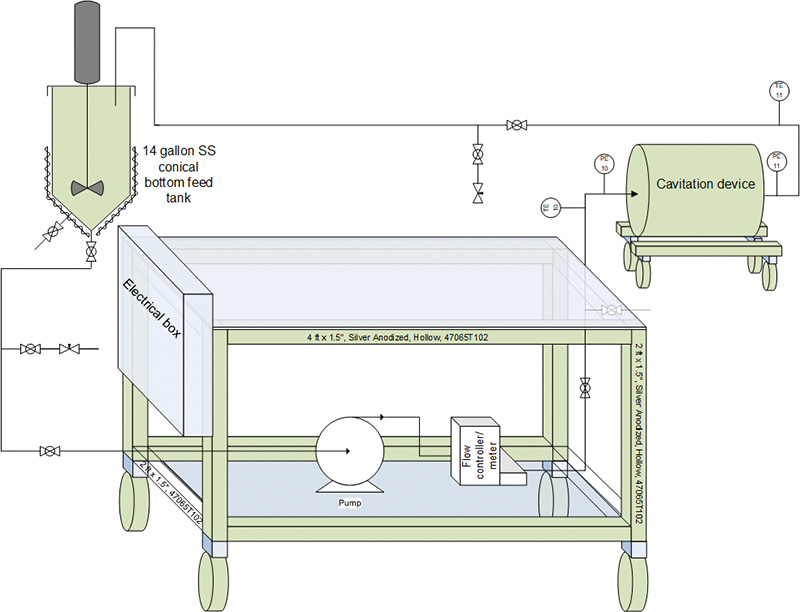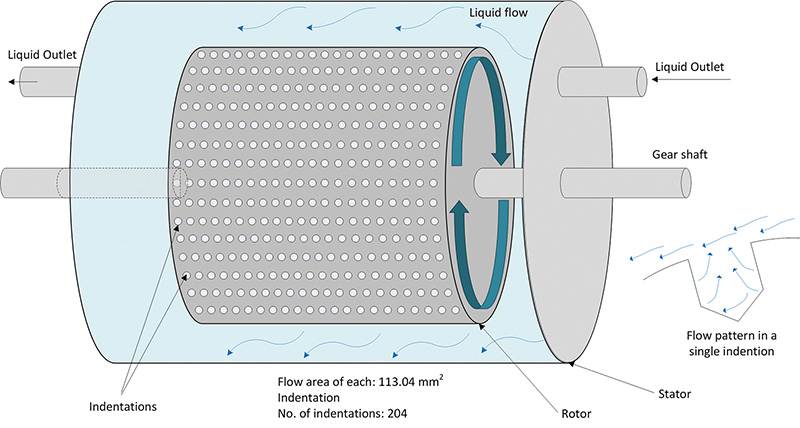March 2022, Vol. 249, No. 3
Features
New Midstream Heavy Crude Oil Processing Technique for Transportation
By James Wood, Project Manager, SwRI
Transporting heavy crude oils through pipeline or by other transportation means is challenging, often requiring the petroleum industry to distribute via truck or rail and adding significant expense and hazards to transportation.
Heavy and extra-heavy crude oils are difficult to transport via pipelines for a range of reasons. These challenges are associated with their high viscosities, asphaltene and paraffin deposition, increased content of formation water, salt content and corrosion issues.1 This article presents a possible solution to these problems.
Producing and transporting heavy crude oil and bitumen is at least twice as capital- and energy-intensive as producing and transporting conventional oil.2
The expenses and energy requirements associated with the production and transport of heavy crude oil arise from the high viscosity at reservoir conditions, as well as the presence of undesirable compounds such as asphaltenes, heavy metals and sulfur.
These characteristics make heavy crude oils difficult to produce, move by pipeline and refine. Currently, oil service and production companies apply heat and inject chemical additives to heavy crude oils to facilitate their transportation by pipeline. However, pipelines are widely regarded as the most attractive option for transporting crude oils.
Pipelines offer low costs and relatively low environmental impacts compared to other transport options that require loading and unloading oil in environmentally sensitive places.
Southwest Research Institute (SwRI) scientists and engineers developed the EZ Flow™ process to treat heavy crude oils, making pipeline transportation of heavy crude oil and similar viscous commodities more cost-effective and less energy intensive than current techniques used to transport heavy crude oils.
The process combines hydrodynamic cavitation (HC) with the addition of proprietary chemical formulations to reduce the heavy crude oil’s viscosity by over 60%, helping it flow more easily through existing pipelines.
Background
The driving force behind the development of a new process for making heavy crude oils flowable in a pipeline is the increasing production of heavy crude oil by petroleum producers worldwide. For example, at least 50% of crude oil reserves in Mexico are heavy and extra-heavy crude oils.3
Canada currently relies on heavy crude oil to meet production needs, producing about 700,000 bpd of synthetic crude oil coming from heavy crude oil, bitumen and tar sands. These synthetic crudes are transported via pipelines to refineries in Canada and the U.S.2
The current technologies used to facilitate transport of heavy crudes are expensive, requiring large volumes of chemicals or diluent and tremendous energy resources in the form of heat. They often require multiple treatment techniques simultaneously or the addition of diluent down the pipeline.
Non-pipeline transportation methods, such as rail or tanker trucks, are expensive, incurring fuel costs, transport maintenance, and high potential environmental impact associated with derailment and collision risks.
For example, air pollution and greenhouse gas costs associated with moving a fully loaded 100-car train of crude oil from North Dakota to the Gulf Coast costs about $150,000 one-way.
The same transportation to the East Coast would cost about $210,000. The total estimated air pollution and greenhouse gas damages for oil shipped by rail from North Dakota in 2014 exceeded $420 million.4
A literature review of current heavy crude oil pipeline transportation technologies concluded that, “For the increasing exploitation of heavy oil and bitumen, it is necessary to develop technology to aid in their transportation through pipelines.”
Of more than 80 MMbpd of crude oil produced globally, about 11 million barrels are classified as heavy crude oils.5 Clearly new transport solutions are needed.
Relevant Theory
Logistically, transporting heavy crude oil and bitumen via pipeline is challenging at best and often impossible considering the high density and viscosity (≥ 1,000 cP at 40° C) and very low mobility at reservoir temperatures of the commodity.2
Reasons for nonconventional oil’s high density and high viscosity include the precipitation of the asphaltene’s macromolecules and their subsequent aggregation in the oil, thus contributing greatly to its pipeline flow resistance. In addition to contributing to impaired mobility, this propensity results in pipeline deposition and plugging.
The high viscosity of crudes is largely associated with the intermolecular forces between these large, branched molecules and the tendency of the asphaltenes and paraffins to coalesce, producing aggregates of heavy hydrocarbons. Those agglomerations structurally compress the oil and reduce its relative volume.
That, in turn, increases the density or American Petroleum Institute (API) weight of the heavy crude oil. Because of these natural physical and chemical properties, heavy crude oils and extra-heavy crude oils are difficult to transport in general and very difficult to transport via pipeline over long distances.
Process Summary
Chemists performed prescreening bench-scale testing to determine the best candidate chemical formulations for scale-up treatment of the heavy crude oil in a 14-gallon EZ Flow test system (Figure 1).
The team then used the formulations that showed the most promising viscosity reduction potential at the bench-scale to treat heavy crude oil in the 14-gallon pilot plant that optimized the chemical treatment of the heavy crude oil by incorporating specialized mixing equipment into the process.
This chemical formulation bench-scale screening process is available for interested parties that want to optimize viscosity reduction for their specific heavy crude, extra-heavy crude and bitumen products. The exact formulation depends upon the properties of the specific heavy material being treated.
The EZ Flow pilot plant heated 12° API heavy crude oil to 40° C in a stirred-stainless-steel, conical-bottom vessel while mixing low-concentration chemicals into the heavy crude oil in a specific order.
Then a pump circulated the heated heavy crude oil/chemical mixture through the hydrodynamic cavitation mixing device using specified energy input. While the demonstration system circulated the mixture through multiple passes, chemists anticipate that a commercial unit would treat the heavy crude/chemical mixture in a single pass (Figure 3).
Heavy crude oils are characterized by a low (< 22) API gravity and a high viscosity (i.e., > 1000 centipoise (cP) at 298 °K). The API and composition of conventional oil, heavy oil and residue is summarized in Table 1.
The test results described used Belridge heavy crude oil that has widespread published data and resembles many candidates for transportation.
Chemical formulations included a water-dispersible mixture integrating an aromatic solvent, at least one base solvent, at least one liquid aliphatic hydrocarbon, an organic solvent, and optionally at least one ethoxylated phenol-derived surfactant, and other compounds.
Process optimization for various feeds may include the incorporation of other chemical compound classes as well.
Results
Treatment of Belridge heavy crude oil using the EZ Flow technology reduced kinematic viscosity at 40° C by 60% or more. This reduction is significant because it used low concentrations of added chemicals, 2% or less, and zero to less than 2% water.
Below are the tabulated results for the Belridge heavy crude oil treatments performed. The baseline heavy crude oil kinematic viscosity was compared to the EZ Flow-treated heavy crude oil kinematic viscosity results at 40° C and 100° C.
Chemists evaluated over 30 different chemical formulations at the bench-scale during the initial research effort. Chemical formulations can be optimized for different feeds, bitumen, extra heavy crude oil and other nonconventional heavy crudes.
The results obtained to date have shown promise for the economic transportation of a variety of nonconventional heavy crudes in pipeline. The application to similar heavy and extra-heavy liquids seems promising.
Usage
According to API, the U.S. has more than 190,000 miles of liquid petroleum pipeline that deliver crude oils, including heavy crude oils, to refineries and chemical plants throughout the U.S. The SwRI-developed process is a potentially cost-effective method for transporting heavy and extra-heavy crude oils over long distances by pipeline over various terrain.
The EZ Flow process reduces the intermolecular forces between and inside the agglomerates of the heavy crude oil, promoting dispersion vs. aggregation. The chemical and mechanical treatment of the heavy crude oil work in unison to reduce viscosity.
Chemical additives (Figure 2) reduce the interfacial tension in heavy crudes, while hydrodynamic cavitation (HC) provides enough energy to enhance the chemical action (Figure 3) without requiring bulk heating to break up the aggregates and disperse the asphaltenes. It is like intense local thermal treatment that does not raise the whole mass of oil to the target temperatures needed for the disaggregation.
The proprietary mixture of low-concentration compounds, compared to other treatment options, optimizes the hydrodynamic cavitation of the heavy crude oil and can reduce heavy crude oil viscosity by over 60%.
In addition, the formulation has not been linked to corrosion or scaling issues in the pilot plant unit. Plus, the similarities between formulation and refinery chemicals suggests that the formulation will not interfere with processes or affect equipment at a refinery.
In addition, the chemical formulation’s composition and hydrodynamic cavitation process can be optimized to lower the viscosity of different types of heavy and extra-heavy crude oils from different regions to make any unconventional crude oil suitable for transport through existing pipelines.
Other advantages of this process include very low chemical additive costs and environmentally friendly qualities. The process is not technically demanding and treated oils can be stored for long periods of time without affecting the viscosity improvements.
The process may be scaled-up to a commercially viable operation with low upfront and operational costs. In addition to reducing viscosity to allow for pipeline transportation, the EZ Flow technique could be used to upgrade heavy crude oil. The changes created in the field will facilitate processing in the refinery and will fall well within encompassed operations.
Heavy crude oil upgrading associated with the process will require further research and optimization but could produce significant benefits.
The research performed to date has been developmental, but the application of the technology to industry has the potential to change the dynamics of the unconventional crude oil market, bringing transportation costs more in line with those of conventional crude oil. In the next phase of research, chemical engineers will scale-up the EZ Flow process.
Author: James Wood is a chemist, microbiologist and project manager. He has performed research and development at SwRI for 16 years. Wood has been published in over 20 technical journals, magazines or national conferences in the fields of engineering, chemistry, microbiology and environmental science.
About SwRI: SwRI conducts independent contract research and development for industry and government clients. SwRI’s Chemical Engineering Department has decades of experience developing processes for new feedstocks, fuels, chemicals and petrochemicals in pilot plants and then scaling those processes up for commercial deployment.
Reference:
1 Martinez-Palou, R. (2011). Transportation of Heavy and Extra Heavy Crude Oil by Pipeline: A Review. Journal of Petroleum Science and Engineering, 274-282.
2 Hart, A. (2014). A Review of Technologies for Transporting Heavy Crude Oil and Bitumen via Pipelines. Journal of Petroleum Exploration and Production Technology, 327-336.
3 Investigación y Desarrollo. (2016). New Technology Reduces Transportation Costs of Heavy Oil. Distrito Federal, Mexico: Investigación y Desarrollo.
4 Clay, K. (2017). The External Costs of Transporting Petroleum Products by Pipelines and Rail: Evidence from Shipments of Crude Oil from North Dakota. National Bureau of Economic Research.
5 Gounder, Ramasamy. Introductory Chapter: Heavy Crude Oil Processing - An Overview, Processing of Heavy Crude Oils. IntechOpen, 2019.
6 Rajoriya, Sunil, Carpenter, Jitendra, Saharan, Virendra Kumar and Pandit, Aniruddha B.. “Hydrodynamic cavitation: an advanced oxidation process for the degradation of bio-refractory pollutants” Reviews in Chemical Engineering, vol. 32, no. 4, 2016, pp. 379-411.









Comments